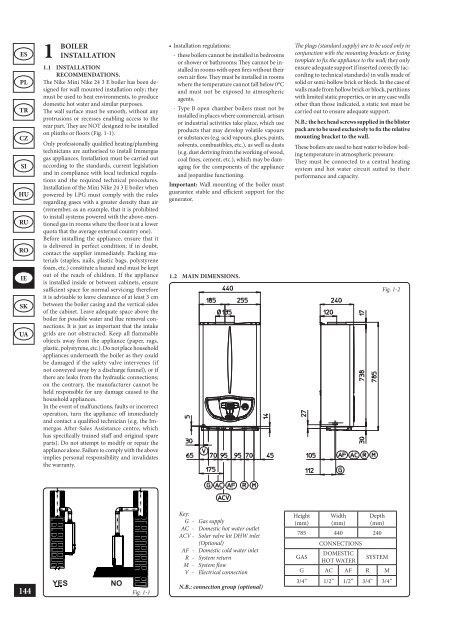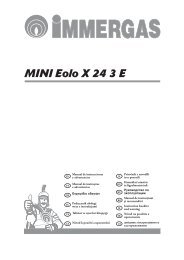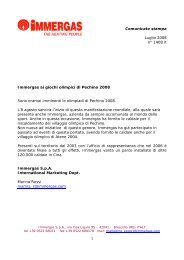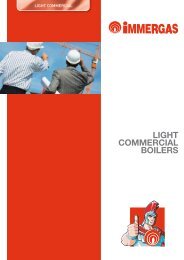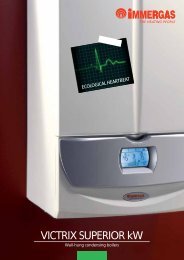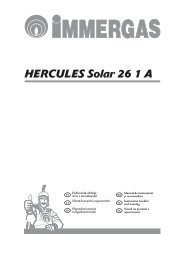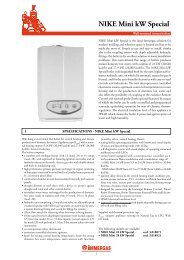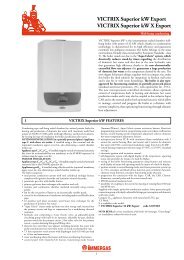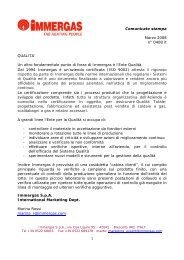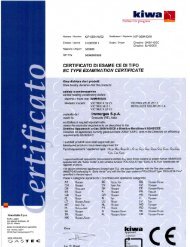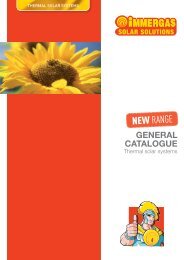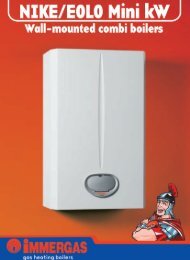MINI Nike 24 3 E - Immergas
MINI Nike 24 3 E - Immergas
MINI Nike 24 3 E - Immergas
You also want an ePaper? Increase the reach of your titles
YUMPU automatically turns print PDFs into web optimized ePapers that Google loves.
ES<br />
PL<br />
TR<br />
CZ<br />
SI<br />
HU<br />
RU<br />
RO<br />
IE<br />
SK<br />
UA<br />
144<br />
1 BOILER<br />
INSTALLATION<br />
1.1 INSTALLATION<br />
RECOMMENDATIONS.<br />
The <strong>Nike</strong> Mini <strong>Nike</strong> <strong>24</strong> 3 E boiler has been designed<br />
for wall mounted installation only; they<br />
must be used to heat environments, to produce<br />
domestic hot water and similar purposes.<br />
The wall surface must be smooth, without any<br />
protrusions or recesses enabling access to the<br />
rear part. They are NOT designed to be installed<br />
on plinths or floors (Fig. 1-1).<br />
Only professionally qualified heating/plumbing<br />
technicians are authorised to install <strong>Immergas</strong><br />
gas appliances. Installation must be carried out<br />
according to the standards, current legislation<br />
and in compliance with local technical regulations<br />
and the required technical procedures.<br />
Installation of the Mini <strong>Nike</strong> <strong>24</strong> 3 E boiler when<br />
powered by LPG must comply with the rules<br />
regarding gases with a greater density than air<br />
(remember, as an example, that it is prohibited<br />
to install systems powered with the above-mentioned<br />
gas in rooms where the floor is at a lower<br />
quota that the average external country one).<br />
Before installing the appliance, ensure that it<br />
is delivered in perfect condition; if in doubt,<br />
contact the supplier immediately. Packing materials<br />
(staples, nails, plastic bags, polystyrene<br />
foam, etc.) constitute a hazard and must be kept<br />
out of the reach of children. If the appliance<br />
is installed inside or between cabinets, ensure<br />
sufficient space for normal servicing; therefore<br />
it is advisable to leave clearance of at least 3 cm<br />
between the boiler casing and the vertical sides<br />
of the cabinet. Leave adequate space above the<br />
boiler for possible water and flue removal connections.<br />
It is just as important that the intake<br />
grids are not obstructed. Keep all flammable<br />
objects away from the appliance (paper, rags,<br />
plastic, polystyrene, etc.). Do not place household<br />
appliances underneath the boiler as they could<br />
be damaged if the safety valve intervenes (if<br />
not conveyed away by a discharge funnel), or if<br />
there are leaks from the hydraulic connections;<br />
on the contrary, the manufacturer cannot be<br />
held responsible for any damage caused to the<br />
household appliances.<br />
In the event of malfunctions, faults or incorrect<br />
operation, turn the appliance off immediately<br />
and contact a qualified technician (e.g. the <strong>Immergas</strong><br />
After-Sales Assistance centre, which<br />
has specifically trained staff and original spare<br />
parts). Do not attempt to modify or repair the<br />
appliance alone. Failure to comply with the above<br />
implies personal responsibility and invalidates<br />
the warranty.<br />
YES NO<br />
Fig. 1-1<br />
• Installation regulations:<br />
- these boilers cannot be installed in bedrooms<br />
or shower or bathrooms; They cannot be installed<br />
in rooms with open fires without their<br />
own air flow. They must be installed in rooms<br />
where the temperature cannot fall below 0°C<br />
and must not be exposed to atmospheric<br />
agents.<br />
- Type B open chamber boilers must not be<br />
installed in places where commercial, artisan<br />
or industrial activities take place, which use<br />
products that may develop volatile vapours<br />
or substances (e.g. acid vapours, glues, paints,<br />
solvents, combustibles, etc.), as well as dusts<br />
(e.g. dust deriving from the working of wood,<br />
coal fines, cement, etc.), which may be damaging<br />
for the components of the appliance<br />
and jeopardise functioning.<br />
Important: Wall mounting of the boiler must<br />
guarantee stable and efficient support for the<br />
generator.<br />
1.2 MAIN DIMENSIONS.<br />
Key:<br />
G - Gas supply<br />
AC - Domestic hot water outlet<br />
ACV - Solar valve kit DHW inlet<br />
(Optional)<br />
AF - Domestic cold water inlet<br />
R - System return<br />
M - System flow<br />
V - Electrical connection<br />
N.B.: connection group (optional)<br />
The plugs (standard supply) are to be used only in<br />
conjunction with the mounting brackets or fixing<br />
template to fix the appliance to the wall; they only<br />
ensure adequate support if inserted correctly (according<br />
to technical standards) in walls made of<br />
solid or semi-hollow brick or block. In the case of<br />
walls made from hollow brick or block, partitions<br />
with limited static properties, or in any case walls<br />
other than those indicated, a static test must be<br />
carried out to ensure adequate support.<br />
N.B.: the hex head screws supplied in the blister<br />
pack are to be used exclusively to fix the relative<br />
mounting bracket to the wall.<br />
These boilers are used to heat water to below boiling<br />
temperature in atmospheric pressure.<br />
They must be connected to a central heating<br />
system and hot water circuit suited to their<br />
performance and capacity.<br />
Height<br />
(mm)<br />
Width<br />
(mm)<br />
Depth<br />
(mm)<br />
785 440 <strong>24</strong>0<br />
GAS<br />
CONNECTIONS<br />
DOMESTIC<br />
HOT WATER<br />
SYSTEM<br />
G AC AF R M<br />
Fig. 1-2<br />
3/4” 1/2” 1/2” 3/4” 3/4”


